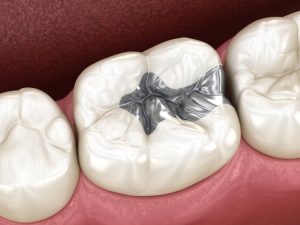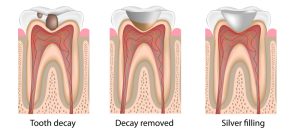Understanding Dental Amalgam Fillings
Dental amalgam fillings are restorative materials used to repair and fill cavities, address tooth decay, and fix damaged teeth. They’re composed of a blend of metals, with mercury, silver, tin, and copper being the primary components. This combination creates a sturdy and long-lasting filling material capable of withstanding the pressures of chewing for many years.
Components of Dental Amalgam Fillings
- Mercury (about 50%)
- Silver (roughly 22-32%)
- Tin (approximately 14%)
- Copper (around 8-12%)
- Small amounts of other metals
Advantages of Amalgam Fillings
Dental amalgam restorations offer several benefits:
- Longevity: Amalgam fillings are remarkably durable and can endure chewing forces for many years.
- Affordability: They’re often less expensive than other dental restoration options, making them accessible to a wide range of patients.
- Strength: Amalgam fillings can withstand heavy chewing loads, making them ideal for molars and high-pressure areas.
- Durability: With proper care, these fillings can last for decades.
- Simple Application: Dentists find amalgam fillings relatively easy to place, often making the procedure quicker than some alternatives.
Drawbacks of Amalgam Fillings
Like all dental treatments, amalgam restorations have some disadvantages:
- Appearance: The silver color of amalgam fillings is noticeable and may be considered unattractive by some patients.
- Temperature Sensitivity: These fillings can expand and contract with temperature changes, potentially leading to tooth fractures or leakage over time.
- Allergic Reactions: Though rare, some individuals may be sensitive to the metals used in amalgam fillings.
- Environmental Concerns: The mercury content in amalgam fillings raises environmental issues if not disposed of correctly.
The Amalgam Filling Process
Tooth Preparation
- Removal of Decayed or Damaged Tooth Structure: Using a drill with a small, spinning head (dental handpiece) and specialized instruments, the dentist will carefully remove the decayed or damaged portion of the tooth. This ensures all the compromised material is eliminated to prevent further problems and create a clean space for the filling.
- Isolation of the Tooth to Keep it Dry: To ensure the success of the filling material and prevent contamination, the dentist will isolate the tooth using a rubber dam. This is a sheet of flexible material with a hole punched in it that fits around the tooth, creating a barrier against saliva and moisture.
- Etching and Application of Bonding Agent: To create a strong bond between the tooth and the filling material, the dentist will roughen the tooth enamel using a weak acid solution (etchant). Then, a bonding agent is applied to the etched surface, which acts like a double-sided tape, ensuring a long-lasting restoration.
Amalgam Preparation and Placement
- Mixing the Dental Amalgam Material: Dental amalgam is a metal alloy that comes in a capsule form. The dentist will mix the capsule contents according to specific instructions to create a workable paste-like consistency for filling the cavity.
- Packing the Mixture into the Prepared Cavity: Using a special tool (plugger), the dentist will meticulously pack the amalgam mixture into the cavity in small increments. This ensures a tight and complete filling to prevent future leakage and ensure the filling’s longevity.
Shaping and Condensing
- Proper Condensation of the Amalgam for Good Adaptation: While packing the dental amalgam, the dentist will apply pressure to condense the material. This ensures there are no air bubbles or voids within the filling, creating a strong and durable restoration that properly fits the cavity shape.
- Carving and Shaping to Match Natural Tooth Anatomy: Once the dental amalgam is condensed, the dentist will meticulously carve and shape it to match the original contours and function of the tooth. This ensures a natural bite and proper chewing function.
Final Touches
- Smoothing and Polishing to Minimize Rough Edges and Enhance Comfort: After shaping the filling, the dentist will smooth and polish the dental amalgam surface using polishing tools and compounds. This removes any roughness that could irritate the tongue or cheek and creates a shiny, natural-looking surface.
Cost of Dental Amalgam Fillings
Patients can expect to pay between $50 to $150 for a single dental amalgam filling. However, dental filling costs can vary based on factors such as cavity size, tooth location, and the dental practice’s location. Most dental insurance plans cover a portion of dental filling treatments.
Safety of Amalgam Fillings
The safety of dental amalgam has been a subject of discussion for years. Here are some key points to consider regarding dental amalgams:
- Mercury Release: Amalgam fillings release small amounts of mercury vapor over time, especially during chewing or brushing. However, the amount released is generally very low.
- Exposure Levels: Studies have shown that while amalgam fillings can increase mercury levels in the body, these levels typically remain well below safety thresholds set by major health organizations.
- Individual Sensitivities: Some people may be more sensitive to mercury or have allergic reactions to dental amalgam components. In these rare cases, alternative filling materials might be recommended.
Replacing Amalgam Fillings
Reasons for replacing dental amalgam fillings include:
- Aesthetic Concerns: Some patients prefer tooth-colored fillings for a more natural look.
- Wear and Tear: Fillings can become worn, cracked, or broken over time.
- New Decay: If decay develops around an existing filling, replacement may be necessary.
- Mercury Concerns: While considered safe by many health organizations, some patients opt for replacement due to concerns about mercury exposure.
If you’re considering replacing your existing dental amalgam fillings, contact Advanced Restorative Dentistry today.
Frequently Asked Questions
The risk of adverse health effects from amalgam fillings is minimal, but some individuals may experience localized allergic reactions.
With proper care, amalgam dental fillings can last 10 to 15 years or even longer.
Do You Need Dental Fillings?
While amalgam fillings remain a reliable and cost-effective option for dental restorations, they do have some drawbacks. Their durability and longevity make them a valuable choice in dental treatment for many patients. When considering dental fillings, it’s crucial to discuss your options with Dr. Nishime to make an informed decision based on your specific needs and preferences. If you’re interested in replacing your amalgam filling with a tooth-colored alternative, schedule your appointment with our Honolulu, HI dentist today by calling 808-732-0291.






